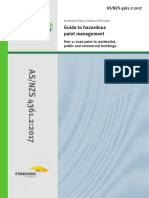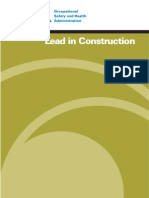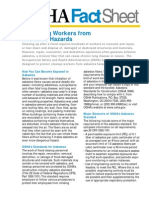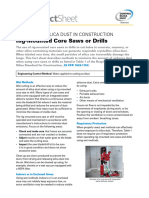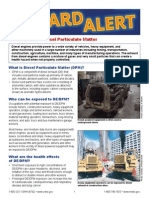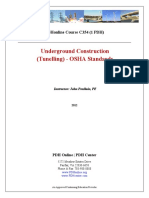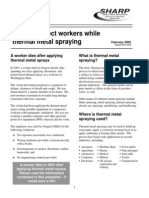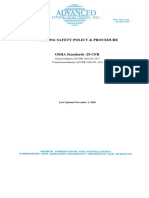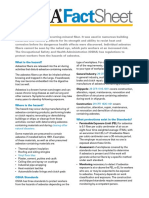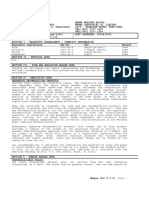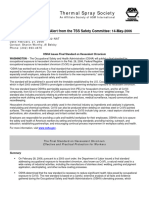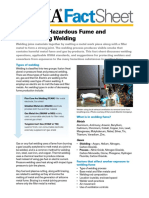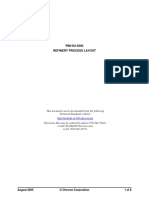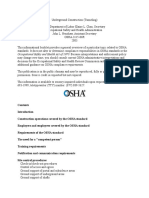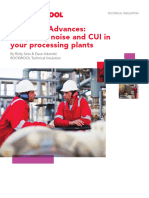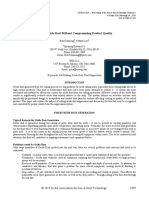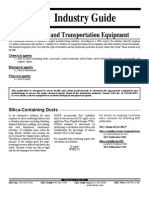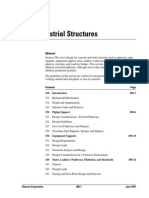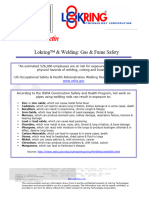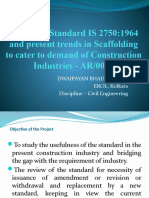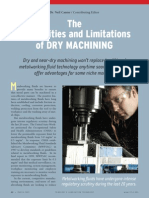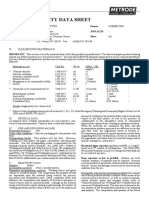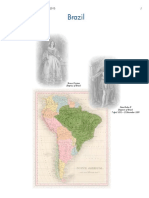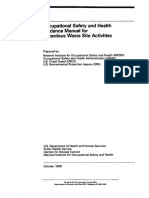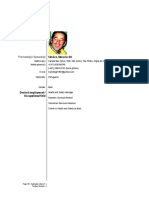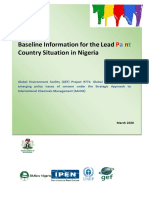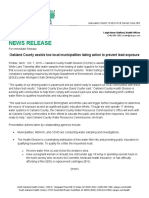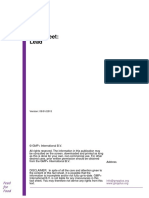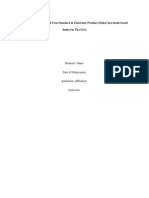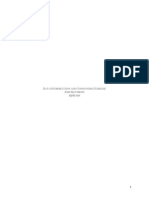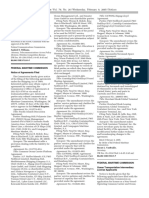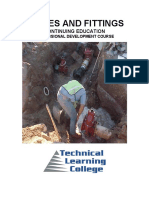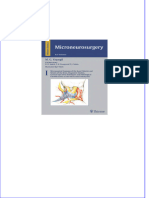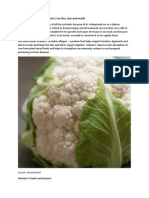Professional Documents
Culture Documents
Sheet: Protecting Workers From Lead Hazards
Sheet: Protecting Workers From Lead Hazards
Uploaded by
Marcelo Gil Simões0 ratings0% found this document useful (0 votes)
18 views2 pagesThe document discusses OSHA regulations to protect construction workers from lead exposure during renovation, repair, or demolition projects. Lead is commonly found in paint, solder, and other building materials. Workers involved in activities like demolition, abrasive blasting, welding, or removing lead paint are at risk of inhaling or ingesting dangerous amounts of lead dust and fumes. OSHA has established regulations including exposure limits, engineering controls, hygiene practices, protective equipment, and medical monitoring to minimize these risks for workers handling materials that may contain lead.
Original Description:
Lead_dangerous_for_health
Original Title
Lead - FS
Copyright
© © All Rights Reserved
Available Formats
PDF, TXT or read online from Scribd
Share this document
Did you find this document useful?
Is this content inappropriate?
Report this DocumentThe document discusses OSHA regulations to protect construction workers from lead exposure during renovation, repair, or demolition projects. Lead is commonly found in paint, solder, and other building materials. Workers involved in activities like demolition, abrasive blasting, welding, or removing lead paint are at risk of inhaling or ingesting dangerous amounts of lead dust and fumes. OSHA has established regulations including exposure limits, engineering controls, hygiene practices, protective equipment, and medical monitoring to minimize these risks for workers handling materials that may contain lead.
Copyright:
© All Rights Reserved
Available Formats
Download as PDF, TXT or read online from Scribd
Download as pdf or txt
0 ratings0% found this document useful (0 votes)
18 views2 pagesSheet: Protecting Workers From Lead Hazards
Sheet: Protecting Workers From Lead Hazards
Uploaded by
Marcelo Gil SimõesThe document discusses OSHA regulations to protect construction workers from lead exposure during renovation, repair, or demolition projects. Lead is commonly found in paint, solder, and other building materials. Workers involved in activities like demolition, abrasive blasting, welding, or removing lead paint are at risk of inhaling or ingesting dangerous amounts of lead dust and fumes. OSHA has established regulations including exposure limits, engineering controls, hygiene practices, protective equipment, and medical monitoring to minimize these risks for workers handling materials that may contain lead.
Copyright:
© All Rights Reserved
Available Formats
Download as PDF, TXT or read online from Scribd
Download as pdf or txt
You are on page 1of 2
FactSheet
Protecting Workers from Lead Hazards
Cleaning up after a flood requires hundreds of workers to renovate and repair, or
tear down and dispose of, damaged or destroyed structures and materials. Repair,
renovation and demolition operations often generate dangerous airborne concen-
trations of lead, a metal that can cause damage to the nervous system, kidneys,
blood forming organs, and reproductive system if inhaled or ingested in danger-ous
quantities. The Occupational Safety and Health Administration (OSHA) has
developed regulations designed to protect workers involved in construction
activities from the hazards of lead exposure.
How You Can Become Exposed to Lead Federal Regulations (CFR), Part 1926.62. This
Lead is an ingredient in thousands of prod- program is essential to minimize worker risk of
ucts widely used throughout industry, includ- lead exposure. Construction projects vary in
ing lead-based paints, lead solder, electrical their scope and potential for exposing workers
fittings and conduits, tank linings, plumbing to lead and other hazards. Many projects
fixtures, and many metal alloys. Although involve only limited exposure, such as the
many uses of lead have been banned, lead- removal of paint from a few interior residential
based paints continue to be used on bridges, surfaces, while others may involve substantial
railways, ships, and other steel structures exposures. Employers must be in compliance
because of its rust- and corrosion-inhibiting with OSHA’s lead standard at all times. A
properties. Also, many homes were painted copy of the standard and a brochure— Lead
with lead-containing paints. Significant lead in Construction (OSHA 3142) —describing
exposures can also occur when paint is how to comply with it, are avail-able from
removed from surfaces previously covered OSHA Publications, P.O. Box 37535,
with lead-based paint. Washington, D.C. 20013-7535, (202)
693-1888(phone), or (202) 693-2498(fax); or
Operations that can generate lead
visit OSHA’s website at www.osha.gov.
dust and fumes include:
• Demolition of structures; Major Elements of OSHA’s Lead
• Flame-torch cutting;
Standard
• Welding; • A permissible exposure limit (PEL) of 50
micrograms of lead per cubic meter of air,
• Use of heat guns, sanders, scrapers, or as averaged over an 8-hour period.
grinders to remove lead paint; and
• Requirements that employers use engi-
• Abrasive blasting of steel structures neering controls and work practices, where
feasible, to reduce worker exposure.
OSHA has regulations governing construc-tion • Requirements that employees observe
worker exposure to lead. Employers of good personal hygiene practices, such as
construction workers engaged in the repair, washing hands before eating and taking a
renovation, removal, demolition, and salvage shower before leaving the worksite.
of flood-damaged structures and materials are • Requirements that employees be provided
responsible for the development and with protective clothing and, where neces-
implementation of a worker protection pro- sary, with respiratory protection accor-
gram in accordance with Title 29 Code of dance with 29 CFR 1910.134.
• A requirement that employees exposed to Additional Information
high levels of lead be enrolled in a medical For more information on this, and other
surveillance program. health-related issues impacting workers, visit
OSHA’s Web site at www.osha.gov.
This is one in a series of informational fact sheets highlighting OSHA programs, policies or
standards. It does not impose any new compliance requirements. For a comprehensive list of
compliance requirements of OSHA standards or regulations, refer to Title 29 of the Code of Federal
Regulations. This information will be made available to sensory impaired individuals upon
request. The voice phone is (202) 693-1999; teletypewriter (TTY) number: (877) 889-5627.
For more complete information:
U.S. Department of Labor
www.osha.gov
(800) 321-OSHA
DSTM 11/2005
You might also like
- Guide To Hazardous Paint Management - ASNZS 4361.2.2017 - Part 2 - Lead Paint in Residential, Public and Commercial BuildingsDocument10 pagesGuide To Hazardous Paint Management - ASNZS 4361.2.2017 - Part 2 - Lead Paint in Residential, Public and Commercial Buildingshitman13630% (1)
- Safe Handling of AsbestosDocument124 pagesSafe Handling of AsbestosMarcelo Gil SimõesNo ratings yet
- Mig Wire ER 70S-6 SpecificationsDocument2 pagesMig Wire ER 70S-6 Specificationsabhics67No ratings yet
- Lead Awareness Toolbox TalkDocument2 pagesLead Awareness Toolbox Talkarunengg100% (1)
- Lead in Construction: WWW - Osha.govDocument38 pagesLead in Construction: WWW - Osha.govAndrej GoronjaNo ratings yet
- Asbestos HazardsDocument2 pagesAsbestos HazardsNuman RanaNo ratings yet
- Ppe09 037 PDF enDocument40 pagesPpe09 037 PDF enVishnu VijayanNo ratings yet
- NR 18 Controlling Silica Exposure in ConstructionDocument72 pagesNR 18 Controlling Silica Exposure in ConstructionCPSSTNo ratings yet
- OSHA3732Document2 pagesOSHA3732ZakirhasNo ratings yet
- Lead and SilicaDocument11 pagesLead and SilicayawarhassanNo ratings yet
- OSHA3929Document2 pagesOSHA3929Herminio Román MoralesNo ratings yet
- Osha Diesel Exhaust and Diesel Particulate MatterDocument4 pagesOsha Diesel Exhaust and Diesel Particulate MatterblackywhiteNo ratings yet
- WP Weld and Metalworking Fume RemovalDocument7 pagesWP Weld and Metalworking Fume RemovalRuben AugustoNo ratings yet
- Underground Construction TunellingDocument31 pagesUnderground Construction TunellingVibhanshu MishraNo ratings yet
- Top Hazards in Construction SitesDocument11 pagesTop Hazards in Construction Sitesabegaa aberaNo ratings yet
- Fumes & GasesDocument2 pagesFumes & GasesPaul NeedhamNo ratings yet
- Thermal Metal SprayingDocument4 pagesThermal Metal SprayingArlen NurlanNo ratings yet
- Canada Eaco Lead Guideline FinalDocument54 pagesCanada Eaco Lead Guideline FinalHannah Mae100% (1)
- Als-Welding Safety Policy ProcedureDocument28 pagesAls-Welding Safety Policy ProcedureRicardoNo ratings yet
- Osha3507 PDFDocument2 pagesOsha3507 PDFSwarg VibhaNo ratings yet
- Writing Safety Into Your Coating SpecificationDocument5 pagesWriting Safety Into Your Coating SpecificationJosé AvendañoNo ratings yet
- Material Safety Data Sheet (MSDS) : Msds No: Aluminum Electrode REVISED 12-2009Document2 pagesMaterial Safety Data Sheet (MSDS) : Msds No: Aluminum Electrode REVISED 12-2009Rama Krishna Reddy DonthireddyNo ratings yet
- Aluminum Wires and Rods 1Document2 pagesAluminum Wires and Rods 1OteranmoralesNo ratings yet
- Material Safety Data Sheet: I. Product IdentificationDocument2 pagesMaterial Safety Data Sheet: I. Product IdentificationElMacheteDelHuesoNo ratings yet
- Product Name: Galvalume Sheet Severstal Sparrows Point LLCDocument4 pagesProduct Name: Galvalume Sheet Severstal Sparrows Point LLCT Bagus Tri LusmonoNo ratings yet
- Standard On Hexavalent ChromiumDocument3 pagesStandard On Hexavalent ChromiumFaisal NadoNo ratings yet
- La 71 MSDSDocument2 pagesLa 71 MSDSdeepak2803No ratings yet
- Osha 3902Document101 pagesOsha 3902Derecho Laboral IndividualNo ratings yet
- White Paper - The Basics of Laser Fume ExtractionDocument8 pagesWhite Paper - The Basics of Laser Fume Extractionrushian65No ratings yet
- Controlling Hazardous Fumes and Gases During WeldingDocument2 pagesControlling Hazardous Fumes and Gases During WeldingMohd MustafhaNo ratings yet
- PIM-DU-5093 Refinery Process Layout: This Document Can Be Downloaded From The Following Technical Standards WebsiteDocument8 pagesPIM-DU-5093 Refinery Process Layout: This Document Can Be Downloaded From The Following Technical Standards Websiteamadan64No ratings yet
- Cms-2 Detector de MonoxidoDocument17 pagesCms-2 Detector de MonoxidoJORGEALEXERNo ratings yet
- Material Safety Data Sheet: I. Product IdentificationDocument2 pagesMaterial Safety Data Sheet: I. Product IdentificationElMacheteDelHuesoNo ratings yet
- PPL100 General InformationDocument5 pagesPPL100 General InformationAnonymous PkeI8e84RsNo ratings yet
- 51 EX Msds 9-07Document3 pages51 EX Msds 9-07Mohamed AdelNo ratings yet
- Nueva Normativa de Espacios Confinados - OSHADocument162 pagesNueva Normativa de Espacios Confinados - OSHAMiguelAngelCastroSanchezNo ratings yet
- Tunelling - OSHA StandardDocument19 pagesTunelling - OSHA StandardDavidZuarsaNo ratings yet
- Rw-Ti Lngacoustics Whitepaper enDocument8 pagesRw-Ti Lngacoustics Whitepaper enCristi DemNo ratings yet
- Civil EngineeringDocument11 pagesCivil EngineeringPradeepNo ratings yet
- Reduce Oxide Dust Without Compromising Product QualityDocument8 pagesReduce Oxide Dust Without Compromising Product QualityJJNo ratings yet
- 30cfr250 Sub Part HDocument149 pages30cfr250 Sub Part HmtstellyNo ratings yet
- Safe Welding PracticesDocument10 pagesSafe Welding PracticesMark MianoNo ratings yet
- Industry Guide: Automobile and Transportation EquipmentDocument3 pagesIndustry Guide: Automobile and Transportation EquipmentNimalton TonNo ratings yet
- Civ 300Document70 pagesCiv 300liamo8888No ratings yet
- Hazards in Medical & Dental Offices (OSHA)Document2 pagesHazards in Medical & Dental Offices (OSHA)Aizen Myo-o AcitNo ratings yet
- Welding Series FumesDocument5 pagesWelding Series FumeskrazygreaseNo ratings yet
- Review of Standard IS 2750:1964 and Present Trends in Scaffolding To Cater To Demand of Construction Industries - AR/0066Document23 pagesReview of Standard IS 2750:1964 and Present Trends in Scaffolding To Cater To Demand of Construction Industries - AR/0066VinodNo ratings yet
- Purafil Corrosion Classification CouponsDocument33 pagesPurafil Corrosion Classification CouponsGreg StoneNo ratings yet
- The Possibilities and Limitations of Dry Machining by Dr. Neil CanterDocument6 pagesThe Possibilities and Limitations of Dry Machining by Dr. Neil CanterpptmnltNo ratings yet
- S 800wtxm 12k Msds EngDocument2 pagesS 800wtxm 12k Msds Eng이상훈No ratings yet
- MsdsDocument3 pagesMsdsTobi MazzoccaNo ratings yet
- What Is Corrosion Under InsulationDocument7 pagesWhat Is Corrosion Under Insulationanggara_nurrachman123No ratings yet
- Final Concrete Cutting and Drilling Doc CroppedDocument20 pagesFinal Concrete Cutting and Drilling Doc CroppedEhab SaadNo ratings yet
- Aws C2Document8 pagesAws C2dehamanezNo ratings yet
- Design of Safe Bulk Solid Containers Code of Practice 1328 PDFDocument38 pagesDesign of Safe Bulk Solid Containers Code of Practice 1328 PDFDinh Viet HaiNo ratings yet
- WP LOTO Past Present FutureDocument7 pagesWP LOTO Past Present FutureishaqNo ratings yet
- Process Perils: Protect Plants FromDocument32 pagesProcess Perils: Protect Plants FromEliécer DoriaNo ratings yet
- Material Safety Data Sheet: I. Product IdentificationDocument2 pagesMaterial Safety Data Sheet: I. Product IdentificationElMacheteDelHuesoNo ratings yet
- Welding Fume Fact SheetDocument2 pagesWelding Fume Fact SheetAek JayNo ratings yet
- Tungsten MSDS 09Document2 pagesTungsten MSDS 09Serkan ApayNo ratings yet
- L24 Workplace Health, Safety And Welfare: Workplace (Health, Safety and Welfare) Regulations 1992. Approved Code of Practice and Guidance, L24From EverandL24 Workplace Health, Safety And Welfare: Workplace (Health, Safety and Welfare) Regulations 1992. Approved Code of Practice and Guidance, L24No ratings yet
- Osh Induction Program in Enhancing Safety Awareness Amongst Fabrication Workers in Brooke Dockyard, Kuching, SarawakFrom EverandOsh Induction Program in Enhancing Safety Awareness Amongst Fabrication Workers in Brooke Dockyard, Kuching, SarawakRating: 5 out of 5 stars5/5 (1)
- Metal Roof Installation Manual: Chapter 6: Roof Deck SubstructuresDocument8 pagesMetal Roof Installation Manual: Chapter 6: Roof Deck SubstructuresMarcelo Gil SimõesNo ratings yet
- 178 GoeggelDocument185 pages178 GoeggelMarcelo Gil SimõesNo ratings yet
- 177 HauptkatalogDocument433 pages177 HauptkatalogMarcelo Gil SimõesNo ratings yet
- 179 MoldauDocument61 pages179 MoldauMarcelo Gil SimõesNo ratings yet
- Occupational Safety and Health Guidance Manual For Hazardous Waste Site ActivitiesDocument142 pagesOccupational Safety and Health Guidance Manual For Hazardous Waste Site ActivitiesMarcelo Gil SimõesNo ratings yet
- OB Afety NalysisDocument4 pagesOB Afety NalysisMarcelo Gil SimõesNo ratings yet
- Curriculum Vitae English English Marcelo Gil Simoes 2018Document6 pagesCurriculum Vitae English English Marcelo Gil Simoes 2018Marcelo Gil SimõesNo ratings yet
- WWW - Mycelia Spawn PleurotusDocument2 pagesWWW - Mycelia Spawn PleurotusMarcelo Gil SimõesNo ratings yet
- Healthmedicinet I 2016 12Document361 pagesHealthmedicinet I 2016 12tuni santeNo ratings yet
- 101 Kebaikan Habbatus SaudaDocument12 pages101 Kebaikan Habbatus SaudaDins PutrajayaNo ratings yet
- Criminal Behavior in IndiaDocument23 pagesCriminal Behavior in IndiaSarmistha MishraNo ratings yet
- Baseline NigeriaDocument56 pagesBaseline NigeriaHellena RobertsonNo ratings yet
- City Limits Magazine, June/July 1983Document32 pagesCity Limits Magazine, June/July 1983City Limits (New York)No ratings yet
- Lead Water Testing Results3Document3 pagesLead Water Testing Results3Anonymous yQDe6aFNo ratings yet
- Astral Upvc Bore-Well Column Pipes For Submersible PumpsDocument18 pagesAstral Upvc Bore-Well Column Pipes For Submersible PumpsshashanksaranNo ratings yet
- Baia Mare CyanideDocument8 pagesBaia Mare CyanideSîrbu VladNo ratings yet
- LigniteDocument23 pagesLigniteMayra Sánchez CabanillasNo ratings yet
- Soal Bahasa InggrisDocument2 pagesSoal Bahasa Inggrisika septianaNo ratings yet
- Describe How The Push For Lead-Free Standard in Electronic Product (RoHS) Increased Social Justice in The USADocument6 pagesDescribe How The Push For Lead-Free Standard in Electronic Product (RoHS) Increased Social Justice in The USATimothy GodwinNo ratings yet
- Forensic ToxicologyDocument165 pagesForensic ToxicologyRoman Mamun100% (2)
- Other Health Impairment Fact SheetDocument8 pagesOther Health Impairment Fact SheetNational Dissemination Center for Children with DisabilitiesNo ratings yet
- Week 8 Data Interpretation AssignmentDocument5 pagesWeek 8 Data Interpretation AssignmentJoshMatthewsNo ratings yet
- Literature Review On Heavy MetalsDocument6 pagesLiterature Review On Heavy Metalsafmzbzdvuzfhlh100% (1)
- Notice: Ocean Transportation Intermediary Licenses: InterCaribbean Cargo, Inc., Et Al.Document2 pagesNotice: Ocean Transportation Intermediary Licenses: InterCaribbean Cargo, Inc., Et Al.Justia.comNo ratings yet
- Forensic ToxicologyDocument165 pagesForensic ToxicologyAnonymous 6QBs1MSiNo ratings yet
- Group 4 - S.I.P Research Paper (Chapter1 - 5) RevisedDocument16 pagesGroup 4 - S.I.P Research Paper (Chapter1 - 5) RevisedKNo ratings yet
- Lead Exposure: Medical Screening Guideline For WorkersDocument10 pagesLead Exposure: Medical Screening Guideline For WorkersSharnella Janet YapfrineNo ratings yet
- 1 Chelation Therapy ® - Longevity Centres of America PDFDocument12 pages1 Chelation Therapy ® - Longevity Centres of America PDFSibia SukhbindarNo ratings yet
- MSDS Gel BatteriesDocument4 pagesMSDS Gel BatteriesosuwiraNo ratings yet
- Valves and Fittings: Continuing EducationDocument308 pagesValves and Fittings: Continuing EducationAbdul Basit SiddiquiNo ratings yet
- Toxicology (6, 7)Document44 pagesToxicology (6, 7)medov43233No ratings yet
- Toxins in Ever Yday Life: Howard Chey,, Susan BuchananDocument21 pagesToxins in Ever Yday Life: Howard Chey,, Susan BuchananAbi RomanoNo ratings yet
- Heavy Metal Toxicology and Human HealthDocument10 pagesHeavy Metal Toxicology and Human HealthKhansaaNo ratings yet
- 7440immediate Download Microneurosurgery Volume I Wei Zhi All ChaptersDocument34 pages7440immediate Download Microneurosurgery Volume I Wei Zhi All ChaptersarbeyhiortNo ratings yet
- Last Minute RevisionDocument63 pagesLast Minute RevisionSachin Shukla100% (1)
- 25 Amazing Benefits of Vitamin C For SkinDocument9 pages25 Amazing Benefits of Vitamin C For SkinAnonymous 6yJx0PzyA0No ratings yet
